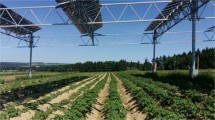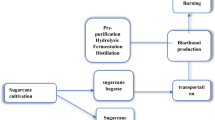Abstract
In this study, a greenhouse-type solar dryer was developed in order to demonstrate an olive oil by-product and agro-residue Managing System, which uses solar drying processes for the treatment of olive oil mill residues to decrease the high energy consumption of the drying operations, thus decreasing the environmental impact of these residues. The resulting by-products, once dried out, have a final application as fuel. The greenhouse, with a roof height of 3.5 m and total area of 150 m2, consisted of three 3.0 × 1.5 × 0.20 m concrete tanks, where the drying of olive pomace (two- and three-phase olive mills), leaves and biomass from pruning for the production of solid biofuels was examined. The two-phase olive mill by-products required more drying time than three-phase olive mill by-products due to higher moisture content. Moreover, the moisture rate was positively related to minimum relative humidity and the highest material and ambient temperature. Using free solar energy for drying olive oil by-products can be beneficial from the point of view of energy consumption and, consequently, the drying system cost. The main innovation of the process is using the most abundantly available energy source in Greece—and the Mediterranean basin generally—the sun.








Similar content being viewed by others
References
Hall, D.O., Rosillo-Calle, F., Williams, R.H., Woods, J.: Biomass for Energy: Supply Prospects. In: Johansson, T.B., Kelly, H., Reddy, A.K.N., Williams, R.H. (eds.) Renewable Energy, Sources for Fuels and Electricity, pp. 593–651. Island Press, Washington, DC (1993)
Goldemberg, J., Johanson, T.B.: World Energy Assessment. Overview 2004 Update, United Nation Development Programme, New York (2004)
Junginger, M., de Visser, E., Hjort-Gregersen, K., Koornneef, J., Raven, R., Faaij, A.: Technological learning in bioenergy systems. Energy Policy 34(18), 4024–4041 (2006)
Hamelinck, C.N., Suurs, R.A.A., Faaij, A.P.C.: International bioenergy transport costs and energy balance. Biomass Bioenergy 29, 114–134 (2005)
Hamelinck, C.N., Faaij, A.P.C.: Outlook for advanced biofuels. Energy Policy 34, 3268–3283 (2006)
Turkenburg. W.C.: Renewable Energy Technologies. UNDP/UN-DESA/WEC, pp. 219–224 (2000)
Van den Broek, R.: Sustainability of Biomass Electricity Systems, p. 216. Department of Science Technology & Society, Utrecht University, Utrecht (2000)
Maragkaki, A., Kotrotsios, T., Samaras, P., Manou, A., Lasaridi, K., Manios, T.: Quantitative and qualitative analysis of biomass from agro-industrial processes in the central macedonia region, Greece. Waste Biomass Valorization (2015). doi:10.1007/s12649-015-9448-2
Meziane, S.: Drying kinetics of olive pomace in a fluidized bed dryer. Energy Convers. Manage. 52, 1644–1649 (2011)
Dermeche, S., Nadour, M., Larroche, C., Moulti-Mati, F., Michaud, P.: Olive mill wastes: biochemical characterizations and valorization strategies. Process Biochem. 48(10), 1532–1552 (2013)
Russo, G., Vivaldi, G.A., de Gennaro, B., Camposeo, S.: Environmental sustainability of different soil management techniques in a high-density olive orchard. J. Clean. Prod. (2014). doi:10.1016/j.jclepro.2014.06.064
El-Abbassi, A., Kiai, H., Raiti, J., Hafidi, A.: Application of ultrafiltration for olive processing wastewaters treatment. J. Clean. Prod. 65, 432–438 (2014)
Pimchuai, A., Dutta, A., Basu, P.: Torrefaction of agriculture residue to enhance combustible properties. Energy Fuels 24, 4638–4645 (2010)
Alwi, S.R.W., Manan, Z.A., Klemes, J.J., Huisingh, D.: Sustainability engineering for the future. J. Clean. Prod. 71, 1–10 (2014)
Bagatin, R., Klemes, J.J., Reverberi, A.P., Huisingh, D.: Conservation and improvements in water resource management: a global challenge. J. Clean. Prod. 77, 1–9 (2014)
Klemes, J.J., Varbanov, P.S., Kravanja, Z.: Recent developments in process integration. Chem. Eng. Res. Des. 91(10), 2037–2053 (2013)
Alba, J., Hidalgo, F.J., Ruiz, M.A., Martínez, F., Moyano, M.J., Borja, R.: Elaboracion de aceite de oliva virgen. In: Barranco, D., Fernandez-Escobar, R., Rallo, L. (eds.) El Cultivo Del Olivo, pp. 551–588. Mundi-Prensa, Madrid (2001)
Fagernas, L., Brammer, J., Wilen, C., Lauer, M., Verhoeff, F.: Drying of biomass for second generation synfuel production. Biomass Bioenergy 34(9), 1267–1277 (2010)
Holmberg, H., Ahtila, P.: Evaluation of energy efficiency in biofuel drying by means of energy and exergy analyses. Appl. Therm. Eng. 25(17–18), 3115–3128 (2005)
Farhad, S., Saffar-Avval, M., Younessi-Sinaki, M.: Efficient design of feedwater heaters network in steam power plants using pinch technology and exergy analysis. Int. J. Energy Res. 32(1), 1–11 (2008)
Panwar, N.L., Kaushik, S.C., Kothari, S.: Role of renewable energy sources in environmental protection: a review. Renew. Sustain. Energy Rev. 15(3), 1513–1524 (2011)
Ekechukwu, O.V., Norton, B.: Review of solar-energy drying systems II: an overview of solar drying technology. Energy Convers. Manage. 40(6), 615–655 (1999)
Sharma, A., Chen, C.R., Lan, N.V.: Solar-energy drying systems: a review. Renew. Sustain. Energy Rev. 13(6–7), 1185–1210 (2009)
Celma, A.R., Rojas, S., López, F., Montero, I., Miranda, T.: Thin-layer drying behaviour of sludge of olive oil extraction. J. Food Eng. 80, 1261–1271 (2007)
Kudra, T., Mujumdar, A.S.: Advanced Drying Technologies. Marcel Dekker, Inc., New York (2002)
Bennamoun, L.: Solar drying of wastewater sludge: a review. Renew. Sustain. Energy Rev. 16, 1061–1073 (2012)
Salihoglu, N.K., Pinarli, V., Salihoglu, G.: Solar drying in sludge management in Turkey. Renew. Energy 32, 1661–1675 (2007)
Arjona, R., Gracia, A., Ollero, P.: The drying of alpeorujo, a waste product of the olive mill industry. J. Food Eng. 41, 229–234 (1999)
Gogus, F., Maskan, M.: Drying of olive pomace by a combined microwave-fan assisted convection oven. Nahrung 45, 129–132 (2001)
Doymaz, I., Gorel, O., Akgun, N.A.: Drying characteristics of the solid by-product of olive oil extraction. Biosyst. Eng. 88, 213–219 (2004)
Roux, N., Jung, D., Pannejon, J., Lemoine, C.: Modelling of the solar drying process Solia. In: Pierucci, S., Ferraris, G.B. (eds.) Proceeding of 20th European Symposium on Computer Aided Process Engineering (2010)
Slim, R., Zoughaib, A., Clodic, D.: Modeling of a solar and heat pump sludge drying system. Int. J. Refrig. 31, 1156–1168 (2008)
Montero, I., Miranda, T., Arranz, J., Rojas, C.: Thin layer drying kinetics of by-products from olive oil processing. Int. J. Mol. Sci. 12, 7885–7897 (2011)
Montero, I., Miranda, T., Arranz, J., Rojas, C.: Solar dryer application for olive oil mill wastes. Energies 8, 14049–14063 (2015)
Vera, D., Jurado, F., Margaritis, N., Grammelis, P.: Experimental and economic study of a gasification plant fuelled with olive industry wastes. Energy Sustain. Dev. 23, 247–257 (2014)
Vaxelaire, J., Cézac, P.: Moisture distribution in activated sludges: a review. Water Res. 38(9), 2215–2230 (2004)
Ekechukwu, O.V., Norton, B.: Review of solar-energy drying systems II: an overview of solar drying technology. Energy Convers. Manag. 40(6), 615–655 (1999)
Velis, C.A., Longhurst, P.J., Drew, G.H., Smith, R., Pollard, S.J.T.: Biodrying for mechanical–biological treatment of wastes: a review of process science and engineering. Bioresour. Technol. 100(11), 2747–2761 (2009)
Ekechukwu, O.V.: Experimental Studies of Integral-Type Natural Circulation Solar-Energy Tropical Crop Dryers. Cranfield Institute of Technology, Cranfield (1987)
Shao, L., Wang, T., Zhao, L., Wang, G., Lü, F., He, P.: The effect of adding straw on natural solar sludge drying. Dry. Technol. 33, 414–419 (2015)
Acknowledgments
This research has been co-funded by the European Union (European Regional Development Fund) and Greek national funds through the National Strategic Reference Framework (NSRF): Program “Development of Industrial Research and Technology (PAVET) 2013” (1359-ΒΕΤ-2013, Production of Organic Fertilizer and Biofuels from Olive Mill Wastes).
Author information
Authors and Affiliations
Corresponding author
Rights and permissions
About this article
Cite this article
Maragkaki, A., Galliou, F., Markakis, N. et al. Initial Investigation of the Solar Drying Method for the Drying of Olive Oil By-Products. Waste Biomass Valor 7, 819–830 (2016). https://doi.org/10.1007/s12649-016-9505-5
Received:
Accepted:
Published:
Issue Date:
DOI: https://doi.org/10.1007/s12649-016-9505-5




